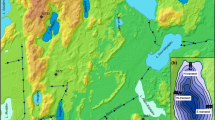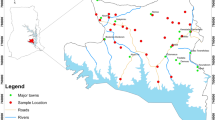Abstract
Due to the increase in open pit mining, pit lakes have become common surface water features, posing a potential risk to subsurface aquifer. In this study, a pit lake–groundwater interaction model is built based on the general program MODFLOW with the LAK3 package. For the first time, the effects of lake-slope collapse and aquifer heterogeneity on pit lake–groundwater interactions are analyzed by dividing the lake into six water exchange zones based on the aquifer lithology and groundwater level. Our investigation and simulations reveal a total water exchange from groundwater to the lake of 349000 m3/a without collapse of the pit lake slope, while the total net water exchange under slope collapse conditions is 248000 m3/a (i.e., a reduction of 1.40-fold). The monthly net water exchange per unit width from groundwater to the lake reaches the largest in April, shifting to negative values in zone IV from June to August and in zone Vin June and July. Moreover, the monthly net water exchange per unit width decreases from north to south, and the direction and magnitude of water exchange are found to depend on the hydraulic gradients between the lake and groundwater and the hydraulic conductivity of the slope collapse.

Similar content being viewed by others
References
Ala-aho P, Rossi P M, Isokangas E, Kløve B (2015). Fully integrated surface–subsurface flow modelling of groundwater–lake interaction in an esker aquifer: model verification with stable isotopes and airborne thermal imaging. Journal of Hydrology (Amsterdam), 522: 391–406
Davis A, Bellehumeur T, Hunter P, Hanna B, Fennemore G G, Moomaw C, Schoen S (2006). The nexus between groundwater modeling, pit lake chemogenesis and ecological risk from arsenic in the Getchell Main Pit, Nevada, U.S.A. Chemical Geology, 228(1–3): 175–196
Downing J A, Watson S B, McCauley E (2001). Predicting cyanobacteria dominance in lakes. Canadian Journal of Fisheries and Aquatic Sciences, 58(10): 1905–1908
Drew L J, Langer W H, Sachs J S (2002). Environmentalism and natural aggregate mining. Natural Resources Research, 11(1): 19–28
El-Zehairy A A, Lubczynski M W, Gurwin J (2018). Interactions of artificial lakes with groundwater applying an integrated MODFLOW solution. Hydrogeology Journal, 26(1): 109–132
Genereux D, Bandopadhyay I (2001). Numerical investigation of lake bed seepage patterns: Effects of porous medium and lake properties. Journal of Hydrology (Amsterdam), 241(3–4): 286–303
Hou D, Li G, Nathanail P (2018). An emerging market for groundwater remediation in China: Policies, statistics, and future outlook. Frontiers of Environmental Science & Engineering, 12(1): 16
Herzsprung P, Schultze M, Hupfer M, Boehrer B, Tümpling W Jr, Duffek A, VanderVeen A, Friese K (2010). Flood effects on phosphorus immobilization in a river water filled pit lake—Case study Lake Goitsche (Germany). Limnologica, 40(2): 182–190
Hunt R J (2003). Ground water-lake interaction modeling using the LAK3 Package for MODFLOW 2000. Ground Water, 41(2): 114–118
McDonald C P, Rover J A, Stets E G, Striegl R G (2012). The regional abundance and size distribution of lakes and reservoirs in the United States and implications for estimates of global lake extent. Limnology and Oceanography, 57(2): 597–606
McJannet D, Hawdon A, Van Niel T, Boadle D, Baker B, Trefry M, Rea I (2017). Measurements of evaporation from a mine void lake and testing of modelling approaches. Journal of Hydrology (Amsterdam), 555: 631–647
Mollema P N, Antonellini M(2016). Water and (bio) chemical cycling in gravel pit lakes: A review and outlook. Earth-Science Reviews, 159: 247–270
Mollema P N, Stuyfzand P J, Juhasz-HoltermanMH A, Van Diepenbeek P M J A, Antonellini M (2015). Metal accumulation in an artificially recharged gravel pit lake used for drinking water supply. Journal of Geochemical Exploration, 150: 35–51
Muellegger C, Weilhartner A, Battin T J, Hofmann T (2013). Positive and negative impacts of five Austrian gravel pit lakes on groundwater quality. Science of the Total Environment, 443(15): 14–23
Peckenham J, Thornton T, Whalen B (2009). Sand and gravel mining: effects on ground water resources in Hancock county, Maine, USA. Environmental Geology, 56(6): 1103–1114
Schneider R L, Negley T L, Wafer C (2005). Factors influencing groundwater seepage in a large, mesotrophic lake in New York. Journal of Hydrology (Amsterdam), 310(1–4): 1–16
Smerdon B D, Mendoza C A, Devito K J (2007). Simulations of fully coupled lake-groundwater exchange in a subhumid climate with an integrated hydrologic model. Water Resources Research, 43(1): W014016
Taviani S, Henriksen H (2015). The application of a groundwater/ surfacewater model to test the vulnerability of Bracciano Lake (near Rome, Italy) to climatic and water-use stresses. Hydrogeology Journal, 23(7): 1481–1498
Været L, Kelbe B, Haldorsen S, Taylor R H (2009). A modelling study of the effects of land management and climatic variations on groundwater inflow to Lake St Lucia, South Africa. Hydrogeology Journal, 17(8): 1949–1967
Verpoorter C, Kutser T, Seekell D A, Tranvik L J (2014). A global inventory of lakes based on high-resolution satellite imagery. Geophysical Research Letters, 41(18): 6396–6402
Virdi M L, Lee T M, Swancar A, Niswonger R G (2013). Simulating the effect of climate extremes on groundwater flow through a lakebed. Ground Water, 51(2): 203–218
Weilhartner A, Muellegger C, Kainz M, Mathieu F, Hofmann T, Battin T J (2012). Gravel pit lake ecosystems reduce nitrate and phosphate concentrations in the outflowing groundwater. Science of the Total Environment, 420(15): 222–228
Acknowledgements
This work was supported by the National Key Research and Development Program of China (No. 2016YFC0402810) and the National Natural Science Foundation of China (Grant No. 41731280).
Author information
Authors and Affiliations
Corresponding author
Rights and permissions
About this article
Cite this article
Zhang, B., Zheng, X., Zheng, T. et al. The influence of slope collapse on water exchange between a pit lake and a heterogeneous aquifer. Front. Environ. Sci. Eng. 13, 20 (2019). https://doi.org/10.1007/s11783-019-1104-9
Received:
Revised:
Accepted:
Published:
DOI: https://doi.org/10.1007/s11783-019-1104-9




